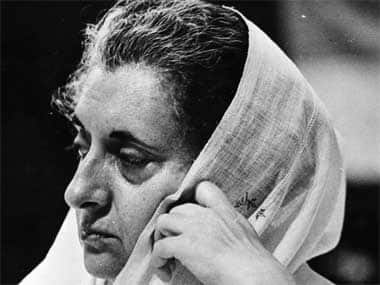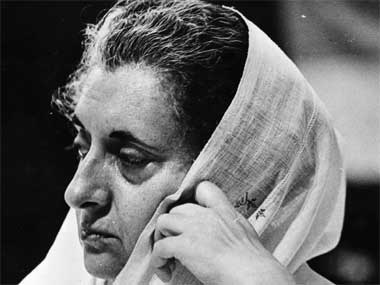There appears to be something almost Freudian about Narendra Modi’s great public show of antipathy towards Indira Gandhi as reflected, for example, in his attempt to ignore so determinedly her 30th death anniversary and instead play up Sardar Patel’s birth anniversary. For, judging from his style, it is hard to ignore the suspicion that somewhere deep down–perhaps in his subconscious–he secretly (and maybe guiltily) admires her and aspires to fashion himself after her in his quest to burnish his “strong leader’’ image. Today, while Congress leaders line up to pay ritualistic tributes to Indira Gandhi, recalling her services to the nation and the party, the irony is that the real heir to her political style is not Rahul Gandhi despite desperate efforts to project him, but an RSS “karya karta” though both he and the Congress , for obvious reasons, can’t bring themselves to admit this. It is striking how quickly, whether consciously or unconsciously, Modi looks set to acquire some of Mrs G’s most distinctive traits–her authoritarianism, her attempt to develop a personality cult both of which ultimately proved disastrous, and her role in systematically destroying her own party in order to consolidate her hold on power . Someone has rightly described him as “Mrs G in trousers minus her cosmopolitanism. [caption id=“attachment_1781307” align=“alignleft” width=“380”]
 Getty[/caption] Under his leadership the BJP has already started to resemble a paler version of the Congress—a sort of “Congress -Mark II” rife with sycophancy, and reeling from clampdown on dissent. So much so that even senior BJP leaders deem it unsafe to open their mouths without making fawning references to “Modi_ji_’s leadership” reminding one of the 1970s Congress. Remember those mandatory salutations to “Indiraji’s dynamic leadership” everytime a Congressperson said something in public? In another echo of that era, there is growing pressure on the media to remain “on message”. Large sections have already started to “crawl when asked to bend” to use L.K. Advani’s memorable phrase . Perhaps the most notable feature of Modi’s style that seems to have come straight from Mrs G’s playbook is his complete domination of the party. He has left no one in doubt on as to who the boss is. The party is becoming increasingly subservient to Modi, the Supreme Leader, as the Congress did under Indira Gandhi. Efforts by a “Modified” BJP to blur the distinction between the party and its leader are reminiscent of what happened under Indira Gandhi. Famously hailed as the “only man in her cabinet” for her strong personality and ruthlessness, she went on to bend the party organisation to her own interests—and, ultimately, destroy it. It seems as we are reliving the 1970s and 1980s, as we see votes being sought not in the name of the party and its policies but in the name of Modi who has become the BJP’s sole vote getter in the same way that Indira Gandhi was. The next step, to complete the circle, will be to identify the whole nation with Modi–a la Dev Kanth Borooah, the late lamented Congress president, who famously declared that “India is Indira, and Indira is India " . Let’s not forget that Modi’s persona, supposedly suffused with qualities associated with a “strong’’ and “decisive’’ leader in the mould of Indira Gandhi, was central to his election campaign. And the seeds of a personality cult then sown continue to be nurtured by his image makeover with a little help from his own rhetoric and actions. In contemporary politics there are precedents for charismatic leaders bursting on the scene in times of public disillusionment with the governing political establishment and thriving by modelling themselves on a famous figure from the other side of the divide. In Britain Tony Blair was dubbed heir to Margaret Thatcher as he sought to cast himself in the image of a tough leader determined to set the world to rights. And he acknowledged his sneaking admiration for her even as he denounced her policies. He went on to win three successive elections for the party, which began to see him ( as the BJP sees Modi, and the Congress saw Mrs G before that) as the sole poll winner. Eventually, however, arrogance did him in and he was forced out of office. Like all strong leaders who become more important than the party, Blair (like Thatcher and Indira Gandhi) had a corrosive influence on Labour’s grassroots organisation and the party lost the very first election it contested after throwing him out. If the conventional wisdom that Modi will be around as PM for at least ten years holds good –and given the state of the opposition that’s a fair assumption–the BJP will have to be very careful to avoid the fate that the Congress and Labour suffered. The BJP is, in fact, at greater risk because of its smaller mass base and grassroot organisational strength. Of course, history doesn’t always repeat itself in the same way and nobody knows how the Modi era will pan out, but it is always useful to remember historical parallels and learn from others’ mistakes.
Getty[/caption] Under his leadership the BJP has already started to resemble a paler version of the Congress—a sort of “Congress -Mark II” rife with sycophancy, and reeling from clampdown on dissent. So much so that even senior BJP leaders deem it unsafe to open their mouths without making fawning references to “Modi_ji_’s leadership” reminding one of the 1970s Congress. Remember those mandatory salutations to “Indiraji’s dynamic leadership” everytime a Congressperson said something in public? In another echo of that era, there is growing pressure on the media to remain “on message”. Large sections have already started to “crawl when asked to bend” to use L.K. Advani’s memorable phrase . Perhaps the most notable feature of Modi’s style that seems to have come straight from Mrs G’s playbook is his complete domination of the party. He has left no one in doubt on as to who the boss is. The party is becoming increasingly subservient to Modi, the Supreme Leader, as the Congress did under Indira Gandhi. Efforts by a “Modified” BJP to blur the distinction between the party and its leader are reminiscent of what happened under Indira Gandhi. Famously hailed as the “only man in her cabinet” for her strong personality and ruthlessness, she went on to bend the party organisation to her own interests—and, ultimately, destroy it. It seems as we are reliving the 1970s and 1980s, as we see votes being sought not in the name of the party and its policies but in the name of Modi who has become the BJP’s sole vote getter in the same way that Indira Gandhi was. The next step, to complete the circle, will be to identify the whole nation with Modi–a la Dev Kanth Borooah, the late lamented Congress president, who famously declared that “India is Indira, and Indira is India " . Let’s not forget that Modi’s persona, supposedly suffused with qualities associated with a “strong’’ and “decisive’’ leader in the mould of Indira Gandhi, was central to his election campaign. And the seeds of a personality cult then sown continue to be nurtured by his image makeover with a little help from his own rhetoric and actions. In contemporary politics there are precedents for charismatic leaders bursting on the scene in times of public disillusionment with the governing political establishment and thriving by modelling themselves on a famous figure from the other side of the divide. In Britain Tony Blair was dubbed heir to Margaret Thatcher as he sought to cast himself in the image of a tough leader determined to set the world to rights. And he acknowledged his sneaking admiration for her even as he denounced her policies. He went on to win three successive elections for the party, which began to see him ( as the BJP sees Modi, and the Congress saw Mrs G before that) as the sole poll winner. Eventually, however, arrogance did him in and he was forced out of office. Like all strong leaders who become more important than the party, Blair (like Thatcher and Indira Gandhi) had a corrosive influence on Labour’s grassroots organisation and the party lost the very first election it contested after throwing him out. If the conventional wisdom that Modi will be around as PM for at least ten years holds good –and given the state of the opposition that’s a fair assumption–the BJP will have to be very careful to avoid the fate that the Congress and Labour suffered. The BJP is, in fact, at greater risk because of its smaller mass base and grassroot organisational strength. Of course, history doesn’t always repeat itself in the same way and nobody knows how the Modi era will pan out, but it is always useful to remember historical parallels and learn from others’ mistakes.
'Mrs G in trousers': Here's why Modi is averse to Indira Gandhi
Hasan Suroor
• October 31, 2014, 21:00:10 IST
Today, while Congress leaders line up to pay ritualistic tributes to Indira Gandhi, the irony is that the real heir to her political style is not Rahul Gandhi, but an RSS “karya karta” though both he and the Congress , for obvious reasons, can’t bring themselves to admit this.
Advertisement
)
End of Article